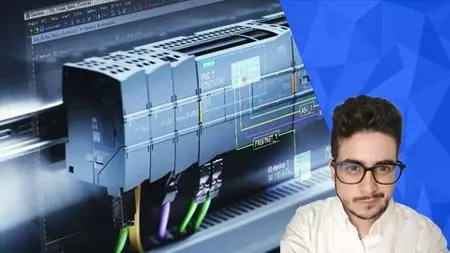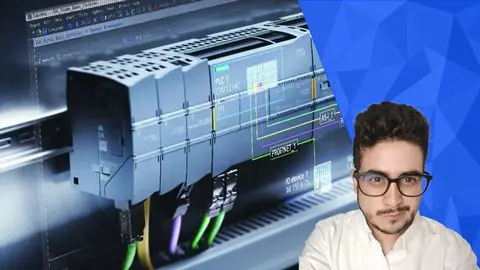Siemens Tia Portal Plc Course Basic & Intermediate Pt1 Plc
Published 2/2024
MP4 | Video: h264, 1920x1080 | Audio: AAC, 44.1 KHz
Language: English | Size: 12.07 GB | Duration: 15h 35m
Published 2/2024
MP4 | Video: h264, 1920x1080 | Audio: AAC, 44.1 KHz
Language: English | Size: 12.07 GB | Duration: 15h 35m
Intermediate basic PLC programming course with TIA Portal Siemens software, different from any other course you have eve
What you'll learn
Learn to program PLCs in a simple way with logical thinking to solve problems in the field.
Advanced Sequences and Instructions from scratch with TIA PORTAL
Usage and programming in Factory IO
Learning and communicating the 4 programming languages focused on SIEMENS
Elaborate complex programs with real industrial exercises carried out in the field.
Learn industrial automation concepts, with a focus on SIEMENS
Basic sequences from scratch with TIA PORTAL
History and SIEMENS Devices in Industry
Requirements
Have completed the TIA PORTAL Basic Course.
Basic Prior Knowledge of TIA PORTAL
Logical sense
Knowledge and Passion for Industrial Programming
Laptop/PC capable of running TIA PORTAL-Factory IO software
If you are passionate or interested in PLC programming, you are welcome to take this course!
Description
IMPORTANT: This is the first part of the complete TIA Portal course with more than 35 hours in total. It is for basic and intermediate levels. If you want to learn TIA Portal and Siemens from a more complex or advanced level, we recommend you to purchase the second part of the course. Thank you.At last the Siemens course is here.Thanks to all of you for the great support I have received over the years.My way of thanking you, is to continue providing courses with the best quality, explained through experience and with situations that will really live in the professional field of automation.Why is this course so different from any other course you have taken before?It is the first course in the world where differences and similarities between the Allen Bradley and Siemens programming environment are explained.Nowadays, the more knowledge we have, the better, therefore, having more than 30 k students around the world, and with knowledge mostly from Allen Bradley, we implemented this new way of teaching so that they do not have complexity when programming between one brand and another.Is the course practical?Thanks to the simulators that will be provided in this course, you can practice and simulate real exercises from your computer.Course syllabus:THEORETICAL SECTION, INTRODUCTION TO SIEMENS.1 Why choose SIEMENS or ALLEN BRADLEY? 2 History of SIEMENS 3 Industrial Automation and Explanation of what is a PLC 4 SIEMENS Processors through History 5 Different S7 Series Processors 6 S7 400 DCS Controller 7 Recommendation and Warning with SIEMENS Software Usage 8 Digital and Analog Signals 9 SIEMENS PLC Components 10 Connecting SIEMENS PLC's 11 Getting to Know SIEMENS Basic Equipment 12 Connecting to PLC'sPROGRAMMING SECTION. BASIC SECTION1 Introduction to the TIA Portal Course 2 Creating Our First Project in TIA Portal (Comparison with Allen Bradley) 3 Essential Knowledge to learn how to Program any PLC 4 Memories and Programming Environment Section5 Physical Memories in TIA Portal-Studio 5000 6 Data Types and Virtual Memories 7 Ladder Language and P1 Memory Addressing 8 Hello World of Industrial Automation (Serial and Parallel) 9 NC, NO, Branch and Forcing Table 10 Coil Repetition (Outputs) and Importance of the NC Blocks 11 SET and RESET Instructions 12 Positive and Negative Edge Instructions 13 TP, TON, TNOR Timers 14 CTU, CTD, CTUD Counters 15 Comparators SIEMENS and ALLEN BRADLEY 16 Absolute and Symbolic Addressing 17 Mathematical Functions 18 Program Blocks 19 TIA Portal and Studio 5000 Arrangements 20 UDT's in TIA Portal and Studio 5000 21 Structures and Difference in UDT's 22 PLC Simulator TutorialPROGRAMMING SECTION, INTERMEDIATE LEVEL1 Variable Tables and Segmentation 2 Memory Optimization 3 Cross Reference, Temporary and Static Memories 4 Startup Values, Snapshots 4 Startup Values, Snapshots 5 General Differences between FC & FB-FC Examples 6 FB Example 7 Multi Instance and Instance Parameter 8 JMP and Label Instructions
Overview
Section 1: Aditional resources
Lecture 1 Programming exercises
Section 2: Introduction to SIEMENS
Lecture 2 History of SIEMENS
Lecture 3 Industrial Automation and Explanation of what is a PLC
Lecture 4 SIEMENS Processors through History
Lecture 5 Different S7 Series Processors
Lecture 6 S7 400 DCS Controller
Lecture 7 Recommendation and Warning with SIEMENS Software Uses
Lecture 8 Digital and Analog Signals
Lecture 9 SIEMENS PLC components
Lecture 10 Connection of SIEMENS PLC's
Lecture 11 Knowing SIEMENS Basic Equipment
Lecture 12 Connecting to PLC - Part 1
Lecture 13 Connecting to PLC - Part 2
Lecture 14 Connecting to PLC - Part 3
Section 3: TIA PORTAL - Basic Section
Lecture 15 Introduction to the TIA Portal Course
Lecture 16 Creating Our First TIA Portal Project (Allen Bradley Comparison)
Lecture 17 Essential knowledge to learn how to program any PLC
Lecture 18 Memories and Programming Environment Section - Part 1
Lecture 19 Memories and Programming Environment Section - Part 2
Lecture 20 Physical Memories in TIA Portal-Studio 5000 - Part 1
Lecture 21 Physical Memories in TIA Portal-Studio 5000 - Part 2
Lecture 22 Data Types and Virtual Memories - Part 1
Lecture 23 Data Types and Virtual Memories - Part 2
Lecture 24 Ladder Language and Memory Addressing P1 - Part 1
Lecture 25 Ladder Language and Memory Addressing P1 - Part 2
Lecture 26 Hello World of Industrial Automation (Serial and Parallel)
Lecture 27 NC, NO, Branch and Forcings Table - Part 1
Lecture 28 NC, NO, Branch and Forcings Table - Part 2
Lecture 29 Coil Repetition (Outputs) and Importance of NC Blocks
Lecture 30 SET and RESET instructions
Lecture 31 Instructions Rising Edge and Falling Edge
Lecture 32 TP, TON, TNOR timers - Part 1
Lecture 33 TP, TON, TNOR timers - Part 2
Lecture 34 CTU, CTD, CTUD Counters - Part 1
Lecture 35 CTU, CTD, CTUD Counters - Part 2
Lecture 36 SIEMENS and ALLEN BRADLEY Comparators
Lecture 37 Absolute and Symbolic Addressing
Lecture 38 Mathematical Functions - Part 1
Lecture 39 Mathematical Functions - Part 2
Lecture 40 Program Blocks
Lecture 41 Arrangements in TIA Portal and Studio 5000
Lecture 42 UDT's in TIA Portal and Studio 5000
Lecture 43 Structures and Difference in UDT's
Section 4: TIA PORTAL - Intermediate Section
Lecture 44 Tables of Variables and Segmentation
Lecture 45 Memory Optimization - Part 1
Lecture 46 Memory Optimization - Part 2
Lecture 47 Cross Reference, Temporary and Static Memories
Lecture 48 Startup Values, Snapshots - Part 1
Lecture 49 Startup Values, Snapshots - Part 2
Lecture 50 General Differences between FC & FB-Examples FC
Lecture 51 Example FB
Lecture 52 Multi Instance and Instance Parameter
Lecture 53 JMP and Label Instructions
Recent graduates in control and automation engineering, mechatronics engineering, robotics engineering, etc.,Junior programmers who are starting their career and wish to increase their knowledge exponentially.,Technicians/Engineers who practice Industrial Programming in any line of business.



